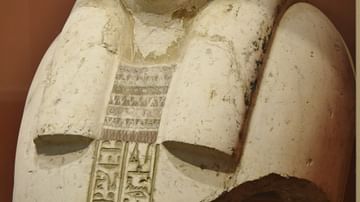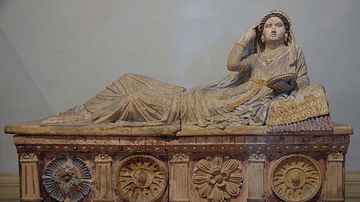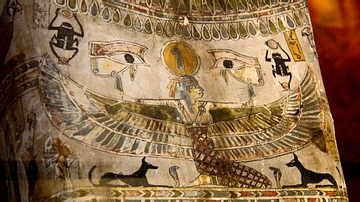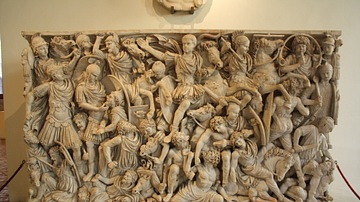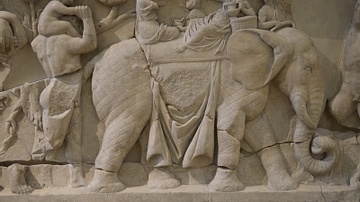Illustration
Sarcophagus of Hapmen, found in Cairo, Ibn Tulun Mosque (reused as a ritual bath); original location is unknown. 26th Dynasty, c. 624-525 BCE.
All surfaces bear figures of gods and funerary texts. Near the head end, one side displays a false door with eyes, allowing the spirit free movement and sight. A spell from the Book of the Dead was thought to help it "come forth by day". The central figure on the long sides (one jackal-headed and one human-headed) is Anubis, the god of mummification. The Sons of Horus at the corners had to guard Hapmen's organs. The goddess Isis mourns at the foot end, as does her sister Nephthys on the head end (not visible). Many more deities appear inside. The floor displays the sky goddess Nut, who embraced Hapmen's mummy, so he could join the everlasting sun and stars. Remarkably, the figures and texts were copied from the sarcophagus of Thutmose III, a king of enduring fame who died a thousand years earlier. Hapmen, a treasurer, lived at a time of proud historical awareness. Thutmose's tomb in Thebes has already lain open for centuries, ever since priests had reburied him and other royals in a cache.
The British Museum, London.
About the Author
Cite This Work
APA Style
Amin, O. S. M. (2016, July 18). Sarcophagus of Hapmen. World History Encyclopedia. Retrieved from https://www.worldhistory.org/image/5351/sarcophagus-of-hapmen/
Chicago Style
Amin, Osama Shukir Muhammed. "Sarcophagus of Hapmen." World History Encyclopedia. Last modified July 18, 2016. https://www.worldhistory.org/image/5351/sarcophagus-of-hapmen/.
MLA Style
Amin, Osama Shukir Muhammed. "Sarcophagus of Hapmen." World History Encyclopedia. World History Encyclopedia, 18 Jul 2016, https://www.worldhistory.org/image/5351/sarcophagus-of-hapmen/. Web. 01 Jul 2025.



